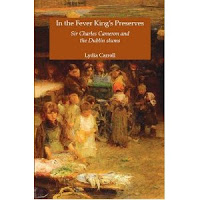Gleanings on Sir Charles Cameron
Earlier in the year the Heritage Centre received a donation of two items relating to Sir Charles Alexander Cameron (1830-1921).
The first is a newspaper gleanings book (
BMS/40) containing cuttings relating to Sir Charles Cameron, covering the period from 1897 to 1919, possibly compiled by his assistant Dr Russell. Most of the cuttings relate to Cameron's professional work; he was Municipal Officer of Health for Dublin and City Analyst, and was actively involved in trying to improve the living conditions and public health provision for Dublin's poorest citizens. As well as covering his professional career, the cuttings relating to his family life, reports on the marriage of his daughter and the death of his sons. As well as the newspaper cuttings there are also some other items, including an invitation to the ceremony where Cameron was to be given the Freedom of the City of Dublin.
There is also a photograph of Sir Charles and Lady Aberdeen in Front Square, Trinity College Dublin. Like Sir Charles, Lady Ishbel Hamilton-Gordon, Marchioness of Aberdeen and Temair, was an active campaigner to improve public health, especially in the fight against Tuberculosis.
The second item, donated at the same time, is a copy of the autobiography of Sir Charles, published in 1921. Although the library already holds a copy of this volume, this new addition is very welcome as it contains important manuscript additions. The volume contains an inscription from Sir Charles to Dr Russell, and at the end Sir Charles had added an additional note to the last chapter which deals with a report written by Cameron on the conditions of the Irish prisoners held at Frongoch Internment Camp following the 1916 uprising - 'Immediately on the receipt of my report the 500 prisoners at Frongoch were released'
These two items are valuable additions to material already held by the Heritage Centre relating to Cameron, which include a Fee Book kept by Cameron in the 1850s and 1860s (
TPCK/6/2/3); the volume also contains notes on his work on the Chemistry of Agriculture, and draft letters relating to his work for the Dublin Sanitary Association. In the College's own archive there are a number of letters relating to the miss-use of doctors names in advertising medical products, a controversy into which Sir Charles was drawn (
RCPI/2/3/3/10). A search of the library catalogue turns up a large number of results for published works produced during Sir Charles' long career; these include his reports as City Analyst, works on public health, agricultural chemistry and geology, food, diet, sanitary conditions, public health, and the history of medicine. Finally, there is a sketch of Cameron made by the artist Frank Leah (
VM/1/2/C/41). The drawing was made only a week before Cameron's death on 27 February 1921.

For those interested in finding out more about the life of Sir Charles Cameron, Lydia Carroll has just published a biography of Cameron – In the Fever King's Preserves. Sir Charles Cameron and the Dublin Slums. Carroll's biography covers both Cameron's personal and professional life and attempts to re-evaluate the career of a man who spent nearly six decades fighting to improve the conditions in Dublin's slums, but whose reputation in his life time was badly damaged by an official report , which Carroll argues was driven by political scape-goating.
In the Fever King's Preserves, Cameron's autobiography, many of his published works, and all the items mentioned in this post can be consulted in the RCPI Heritage Centre reading room –
just get in touch to make an appointment.